
Shanghai Style Icons: The Evolution of Beauty and Power in China's Global City
The qipao-clad silhouette stepping out of a 1920s Packard. The revolutionary worker in her blue Mao suit. The power executive in a tailored suit tapping her Louboutins on the Bund. These images, separated by nearly a century, all represent the Shanghai woman - a cultural phenomenon that has consistently redefined Chinese femininity while maintaining its distinctive local character.
Chapter 1: The Golden Age Glamour (1920s-1940s)
Shanghai's reputation as China's fashion capital began in the jazz age, when the city's women became known as "modeng xiaojie" (modern misses). Historical records show:
- Over 200 qipao tailors operated along Nanjing Road
- 85% of Chinese cosmetics were sold in Shanghai
- Women comprised 37% of the white-collar workforce (unprecedented in Asia)
"These women weren't just pretty faces," explains fashion historian Dr. Mei Lin. "They were typists, telephone operators, and shop owners who used fashion as professional armor."
Chapter 2: The Revolutionary Transformation (1950s-1970s)
The communist revolution brought dramatic changes. The iconic "Shanghai girl" cut her hair short, swapped silk for cotton, and joined the workforce en masse. Factory records reveal:
上海龙凤sh419 - Women's industrial participation reached 68% by 1960
- The iconic "Little Blue Jacket" became universal workwear
- Beauty salons rebranded as "hygiene centers"
Yet even during this austere period, Shanghai women maintained subtle distinctions. "We starched our collars whiter, kept our braids neater," recalls 78-year-old former textile worker Wu Aihua. "Shanghai style never disappeared - it just went underground."
Chapter 3: The Reform Era Rebels (1980s-1990s)
As China opened up, Shanghai women led the beauty revolution. Department store archives document:
- Perms increased 1,200% between 1985-1990
- The first Avon ladies appeared in 1990
- High heels became office staples by 1992
"This was when 'Shanghai girl' became both compliment and stereotype," notes sociologist Dr. Zhang Wei. "People admired their sophistication but criticized their materialism."
上海花千坊龙凤 Chapter 4: The Global Citizens (2000s-Present)
Today's Shanghai woman defies simple categorization. She might:
- Wear a qipao to her startup's launch party
- Practice yoga at dawn before board meetings
- Speak flawless English while haggling in the wet market
"Modern Shanghai femininity is about having options," says tech CEO Fiona Chen. "My grandmother had three outfits her whole life. I might wear three different looks in one day - traditional, professional, avant-garde - all authentically me."
Chapter 5: The Beauty Industrial Complex
Shanghai's beauty industry reflects these evolving ideals:
- 42% of China's cosmetic surgeries occur here
- The "natural makeup" market grows 25% annually
上海品茶网 - Traditional Chinese medicine spas thrive alongside high-tech clinics
"Shanghai women are sophisticated consumers," says beauty entrepreneur Vivian Wang. "They'll spend $500 on French serum but insist on traditional gua sha techniques."
Chapter 6: The Future Shanghainese Woman
Emerging trends suggest tomorrow's Shanghai woman will:
- Lead in STEM fields (female tech founders up 300% since 2015)
- Redefine aging (55+ women are fastest-growing luxury demographic)
- Blend cultural symbols in new ways (qipao with sneakers, jade with smartwatches)
As 28-year-old architect Mia Wu concludes: "Being a Shanghai woman means writing your own rules while honoring where you came from. That's always been our magic."
Through wars, revolutions, and economic transformations, Shanghai women have consistently reinvented beauty on their own terms - making them not just style icons, but living embodiments of China's complex journey to modernity.
